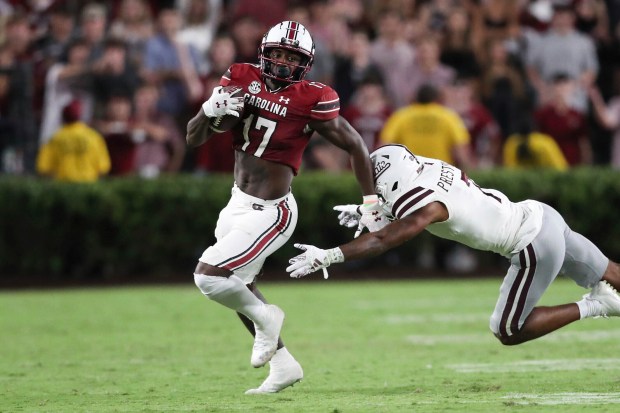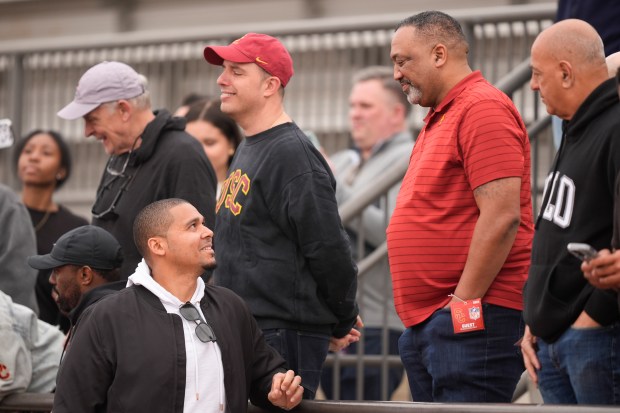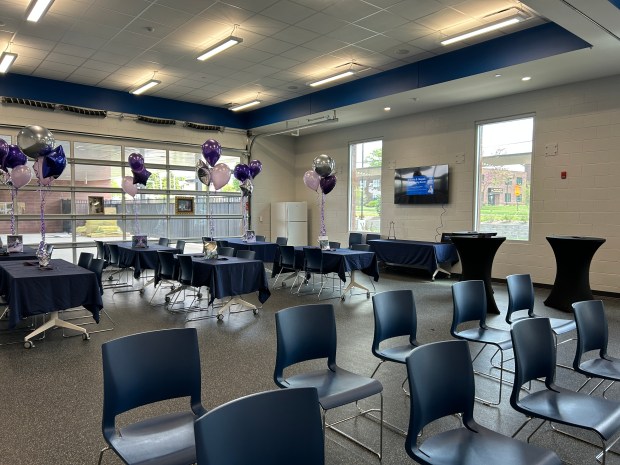The NFL draft begins in 15 days, and all indications continue to suggest the Chicago Bears will select USC quarterback Caleb Williams with the No. 1 pick.
That doesn’t mean there’s no remaining intrigue for the Bears, who also own the No. 9 pick and should have an array of options — including looking to trade up or down.
As he does every Wednesday, the Tribune’s Brad Biggs reaches into the Bears mailbag to answer reader questions.
Why do the Bears have to pretend they’re unsure who they’re taking at No. 1? Everyone and their mother knows they’re drafting Caleb Williams. — @mosconml
I’m not sure they are pretending anything. I’ve been pretty straightforward for quite a while saying all signs point to Williams being the first pick. The folks I have spoken to have been pretty transparent, and I don’t believe anyone is being coy here.
There’s no advantage to the Bears announcing their intent prematurely. Yes, they could negotiate a contract and sign Williams, but he wouldn’t be able to report to Halas Hall for work until after the draft. So there’s no practical reason to publicly declare their intention and hammer out a contract.
In the event something truly bizarre happens, it might be best to wait until Commissioner Roger Goodell puts them on the clock on April 25. Surely the NFL would like all eyeballs focused on television when the draft begins too.
I believe the trade down last season from No. 1 was the greatest trade in Bears history. What would you say is? — @bears_scat
That trade has a possibility to go down as the best in the team’s long and storied history, but you’ll probably have to wait quite a while to make that claim and not get a strong argument. In 1964, the Bears traded second- and fourth-round picks to the Pittsburgh Steelers for their first-round pick in 1965. That turned out to be the No. 3 pick, which the Bears used to select a linebacker by the name of Dick Butkus. I think most would agree the Bears would have to do exceedingly well with their haul from last year’s trade to eclipse the manuever that resulted in Butkus, one of the greatest linebackers ever.
Dick Butkus rushes through the line of scrimmage against the 49ers during a game on Nov. 19, 1972. (Tribune file photo)
In 1938, the Bears traded Edgar Manske in another deal with the Steelers for a first-round pick in 1939, which netted them a quarterback out of Columbia by the name of Sid Luckman. As you know, the Bears have been looking for a franchise quarterback like Luckman for ages. He helped guide them to four championships in 12 seasons. Other fortuitous trades netted the Bears defensive end Doug Atkins in 1955 and a first-round pick in 1979 that turned into defensive lineman Dan Hampton.
The Bears have been around a long time. They’ve made oodles of trades, and a small handful have led to the acquisition of some of the greatest players to wear the uniform. The bar is set high for Caleb Williams and a remaining piece in the trade you’re referencing (the Bears own the Carolina Panthers’ second-round pick in 2025). If Williams is the player the Bears hope — if their collective dreams are realized — it has a chance to be in the conversation.
After we draft Jared Verse at No. 9 or a little lower (after a trade down), what WR should we target who will likely be there in Round 3? — @tonysoprano7716
You and I won’t be drafting anyone on April 25. The Bears could go with an edge rusher with their second first-round pick, and in that scenario I’d expect them to look at a wide receiver or offensive lineman when they get around to selecting in Round 3 (No. 75) on Day 2 of the draft.
With an especially deep and talented group of receivers, the question is when there will be a second run on the position and how quickly they will come off the board. Six wide receivers, maybe seven, are likely to be selected in the first round. A handful will get picked in Round 2 as well.
Which names could be appealing in Round 3? Let’s look at seven options. They’re listed alphabetically, and keep in mind many of them might be gone before the 75th pick rolls around. Part of this depends on specifically what the Bears are seeking to go with DJ Moore and Keenan Allen.

- Javon Baker, Central Florida (6-foot-1, 202 pounds): An Alabama transfer, Baker had a good showing at the scouting combine with a 4.54-second, 40-yard dash and a 37-inch vertical jump. He’s got a good frame and vertical route-running ability along with plus ball tracking skills. Baker showed growth this past season.
- Malachi Corley, Western Kentucky (5-11, 215): I’m not sure Corley will remain available at No. 75, but he’s interesting and built a little differently. He has a very powerful lower body, and that makes him excellent running through contact. As a result, he’s excellent after the catch. His hands are a bit of a question, but he’s intriguing and could be a versatile weapon in the right scheme.
- Xavier Legette, South Carolina (6-1, 221): It would be a little risky to wait for Legette to make it all the way to No. 75, but he’s a Day 2 pick. He helped himself with a strong week at the Senior Bowl and then boosted himself further with a 4.39 time in the 40-yard dash at the scouting combine in Indianapolis. He has a bit of a stiff lower body, and one knock is that he has only straight-line speed. He’s good on contested catches and in traffic.
- Luke McCaffrey, Rice (6-2, 198): He profiled as a Day 3 pick, but after running the 40 in 4.46 seconds, he might move into Day 2. He has excellent hands and is super productive on contested catches, tying Washington’s Rome Odunze for the most in the nation last year with 24. A converted quarterback, McCaffrey has an understanding of the passing game and is improving as a route runner. He needs to show he can do more than play in the slot.
- Jalen McMillan, Washington (6-1, 197): He played primarily in the slot for the Huskies and will have to convince teams he has more versatility at the next level. He has good size and large hands (10 inches) and ran the 40 in 4.47 seconds. He’s a bit of a long strider.
- Ja’Lynn Polk, Washington (6-1, 203): He ran a 4.52-second 40 at the combine. While Polk isn’t super-twitched up, he does well on contested catches and can play in traffic. He offsets what he lacks in speed with good size and body control.
- Brenden Rice, USC (6-2, 208): Jerry Rice’s son and a college teammate of Caleb Williams, Rice has good size and length with 33-inch arms. He ran the 40 in 4.5 seconds and had some explosive jumps in Indianapolis. He’s a physical performer, and while he doesn’t profile like his father, he’s pretty savvy as a route runner and a strong hands catcher.
What compensation would be required for the Bears to trade up to No. 4 or 5 to pick Marvin Harrison Jr.? — @j23wht
You’re looking at a potentially expensive move up that probably would require more than the various trade-value charts show. For starters, that might be a prime area for a quarterback — meaning if the Arizona Cardinals at No. 4 or Los Angeles Chargers at No. 5 have interest in trading down, they could command a serious offer. I think the minimum the Bears would have to offer would be the ninth pick and one of the two 2025 second-round picks they own, likely the one coming from the Carolina Panthers. It wouldn’t surprise me if the Cardinals or Chargers asked for No. 9 and both second-round picks in 2025.
I got a handful of questions about the Bears trading up for Harrison, and this seems to be the social media topic of the week. It’s a great draft for wide receivers and the Bears might be able to get one they have similarly graded by staying put at No. 9. General manager Ryan Poles is short on picks this year, and moving up four or five spots in your scenario would put him at a deficit in 2025.
Do you believe there is a real chance the Bears make a move to trade up for Marvin Harrison Jr. if he’s still available at 5? — @coleadipo11
It’s fun to kick around the idea, but the Bears would have to pay a pretty penny to move up with the Chargers. If four quarterbacks come off the board with the first four picks — and I think that’s possible — the Chargers might be able to get good action for their pick. They also could stay put and choose an offensive tackle, the position I think makes most sense for new coach Jim Harbaugh. Heck, the Chargers could grab Harrison there if they really want.
Ryan Poles has proved to be aggressive at times when it comes to trades, so I wouldn’t rule it out, but I think this is a long shot. Harrison might have to slip beyond No. 5 for it to be more feasible.
Since the combine (and really before), both Ryan Poles and Matt Eberflus have made public statements lauding Caleb Williams and indicating to everyone that Chicago is going to take Williams with the No. 1 pick. Is there a fear that the Bears’ brass are not doing their due diligence on the other top QBs, namely Jayden Daniels, Drake Maye and J.J. McCarthy? I’m not saying that any of them are a better prospect than Williams, but I all too vividly remember Ryan Pace being so enamored with Mitch Trubisky that he neglected to do his homework on Patrick Mahomes and Deshaun Watson. — Chris B.

For starters, if you look back you’re not going to find a lot of public comments by Poles and Eberflus regarding Williams before the combine. In fact, I’m not sure if you will find any that Eberflus made, and Poles was dancing around specific questions about Williams up to that point. I understand the question and why you are asking, but Poles, I believe, has seen every one of those quarterbacks play in person and multiple members of his staff have seen all of the QBs play numerous times, so it’s not like they haven’t been studying the entire class.
Pace and his staff did plenty of work on the 2017 class. I know there were members of the staff who really liked Mahomes. Pace attended Texas Tech games. The error is the Bears locked on to the wrong guy. Outside of Kansas City, how many had Mahomes as the No. 1 quarterback in that class?
Most folks believe Williams is the top QB in this class and have held that belief for a long time. I think this year’s class is more defined than the 2017 class. We’ll see how things unfold, but I expect Williams to be the top pick.
While there has been a lot of talk of other free-agent signings, can you explain why the Bears identified D’Andre Swift as their first target in the early hours of free agency? Do you see Khalil Herbert’s role diminishing? Does this signal the final year for Herbert before he heads to free agency? — Olaf, Memphis, Tenn.
The Bears believe Swift provides an explosive element to their backfield that has been missing, giving them a little bit of a home run threat. He can be solid catching the ball out of the backfield. Probably not great, but the Philadelphia Eagles underutilized that skill last season as they have not placed a great premium on throwing the ball to running backs.
Herbert didn’t make the kind of advancements in pass protection the Bears had hoped for last season. I think there’s still a spot for him and he can get some action, but he’ll have to earn it. Swift doesn’t profile as the kind of guy who will average nearly 20 carries per game, so there will be opportunities for others, whether it’s Herbert, Roschon Johnson or a newcomer.
If J.J. McCarthy had not gone to Michigan, would he be as highly rated as he is in mock drafts? It seems like an awful lot of people are looking at him as Tom Brady II because Brady also played for the Wolverines and was a bit under the radar during his college career. — Mike H., Batavia
Michigan quarterback J.J. McCarthy reacts after running back Blake Corum scored a touchdown during overtime of the Rose Bowl against Alabama on Jan. 1, 2024, in Pasadena, Calif. (AP Photo/Kyusung Gong)
It’s possible McCarthy would be more highly regarded if he had played for a team that was more interested in slinging the rock. One question about McCarthy is his lack of passing volume in Jim Harbaugh’s offense. If he had Drake Maye-type numbers, it’s possible he’d be more popular in mock drafts.
Scouts love McCarthy’s makeup and acumen for the game. He’s athletic and he moves pretty well. While he has a bit of a slight frame, so does LSU’s Jayden Daniels. In the end, mock drafts don’t matter. It’s what teams think about the prospects that matters. I expect McCarthy to be drafted in the top 10, quite possibly the top five.
We know Ryan Poles doesn’t see much value after the fourth round in this year’s draft. Given this, how many picks do you see the Bears having used by the end of the draft? — @balakay
Poles isn’t alone in that sentiment. Scouts have been talking about the lack of depth in this draft for a while, and I noted it back in early February after a trip to the Senior Bowl. The NFL granted 54 non-seniors special eligibility for the draft, down from 63 in 2023 and 73 in 2022. That number was in triple digits in the not-too-distant past. So you’re talking about more than a round’s worth of players (32) from where it was not long ago.
How many picks will the Bears wind up with? I’d say the range is four to six. There’s really no need to collect extra picks on Day 3 (Rounds 4-7) unless the Bears have two or three players in mind they’d really like a shot at. In that case, maybe they would consider a trade down.
Does the Chiefs’ bid for public money to improve Arrowhead Stadium provide any clue to what future the Bears and White Sox have as they seek public funding for new stadiums? — Ernest, Oak Lawn
As I have written in this space before, you’re wading deep into political waters when you talk about stadium issues and more specifically stadium funding issues. Last week in Kansas City, Jackson County voters overwhelmingly defeated a bid by the Chiefs and Royals to boost a sales tax measure that would have helped the Royals build a new stadium and ballpark district and the Chiefs upgrade Arrowhead Stadium. More than 58% of voters rejected the plan. The Chiefs had hoped to get roughly $500 million to pair with $300 million they had pledged to upgrade the stadium.
The upshot here is pretty clear: Sports teams face an uphill battle for funding when measures are put to a public vote. The Bears — and I would guess the Sox — will attempt to navigate this process without requiring public support at the voting booth.




